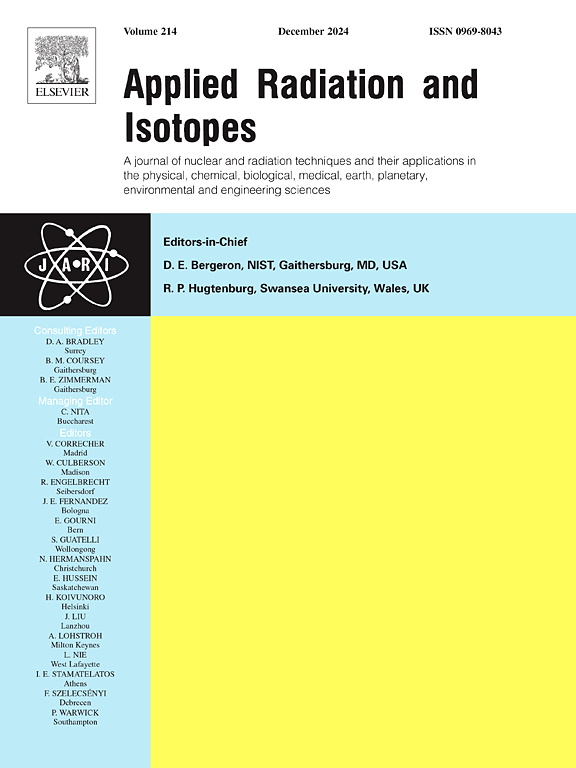Evaluation of bismuth oxide nanoparticles for enhanced gamma-ray/neutron shielding in HDPE-based composites
IF 1.6
3区 工程技术
Q3 CHEMISTRY, INORGANIC & NUCLEAR
引用次数: 0
Abstract
In the present study the shielding efficiencies of gamma and neutron radiations for fabricated composites using high-density polyethylene (HDPE) via the sol-gel method were investigated. These lightweight, low-cost, and ductile materials incorporate xBi2O3 nanoparticles (x = 4.0 %, 12.0 %, 20.0 %, 30.0 %, and 40 %) as a non-toxic nanofiller. The study employed X-ray diffraction (XRD), scanning electron microscopy (SEM), and energy-dispersive X-ray spectroscopy (EDX) to characterize the Bi2O3/HDPE nanocomposites. The effectiveness of these composites in attenuating gamma-ray was assessed by using an HPGe detector. Measurements were conducted across various gamma-ray energies (121, 244, 334, 444, 778, 963, 1112, and 1408 keV) emitted by a standard Eu-152 point source. The relationship between mass attenuation coefficients (μm) and the Bi2O3 loading was investigated at each energy level experimentally and theoretically. Using other shielding parameters, such as half-value layer (HVL) and mean free path (MFP), were also calculated. Total macroscopic neutron cross-section (ΣT) of the composites was also determined using an Am241–Be (α, n) neutron source. It was observed that gamma and neutron shielding properties were improved due to increasing amount of Bi2O3 nanoparticles in the composite.
氧化铋纳米粒子在hdpe基复合材料中增强伽马射线/中子屏蔽的评价
本文采用溶胶-凝胶法研究了高密度聚乙烯(HDPE)复合材料对γ辐射和中子辐射的屏蔽效率。这些轻质、低成本和延展性的材料将xBi2O3纳米颗粒(x = 4.0%、12.0%、20.0%、30.0%和40%)作为无毒的纳米填料。采用x射线衍射(XRD)、扫描电镜(SEM)和能量色散x射线能谱(EDX)对Bi2O3/HDPE纳米复合材料进行表征。使用HPGe探测器评估了这些复合材料衰减伽马射线的有效性。测量了标准Eu-152点源发射的各种伽马射线能量(121,244,334,444,778,963,1112和1408 keV)。从理论上和实验上研究了各能级质量衰减系数(μm)与Bi2O3负载的关系。利用半值层(HVL)和平均自由程(MFP)等其他屏蔽参数也进行了计算。用Am241-Be (α, n)中子源测定了复合材料的宏观总中子截面(ΣT)。研究发现,随着Bi2O3纳米颗粒含量的增加,复合材料的γ和中子屏蔽性能得到了改善。
本文章由计算机程序翻译,如有差异,请以英文原文为准。
求助全文
约1分钟内获得全文
求助全文
来源期刊

Applied Radiation and Isotopes
工程技术-核科学技术
CiteScore
3.00
自引率
12.50%
发文量
406
审稿时长
13.5 months
期刊介绍:
Applied Radiation and Isotopes provides a high quality medium for the publication of substantial, original and scientific and technological papers on the development and peaceful application of nuclear, radiation and radionuclide techniques in chemistry, physics, biochemistry, biology, medicine, security, engineering and in the earth, planetary and environmental sciences, all including dosimetry. Nuclear techniques are defined in the broadest sense and both experimental and theoretical papers are welcome. They include the development and use of α- and β-particles, X-rays and γ-rays, neutrons and other nuclear particles and radiations from all sources, including radionuclides, synchrotron sources, cyclotrons and reactors and from the natural environment.
The journal aims to publish papers with significance to an international audience, containing substantial novelty and scientific impact. The Editors reserve the rights to reject, with or without external review, papers that do not meet these criteria.
Papers dealing with radiation processing, i.e., where radiation is used to bring about a biological, chemical or physical change in a material, should be directed to our sister journal Radiation Physics and Chemistry.
 求助内容:
求助内容: 应助结果提醒方式:
应助结果提醒方式:


